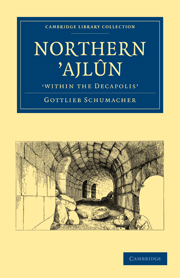Summary
THE NÂHIYET OR DISTRICT OF ES-SIRU
The Nâhiyet es-Siru is bounded on the north by the Yarmûk River; on the east by the Wâdy Samar and the Nâhiyet el-Kefarat; on the south by the Wâd el-Arab, the Nâhiyets of El-Wustîyeh, and Beni Juhma; and on the west by the Jordan Ghôr. The district consists, physically, of a mountain shoulder, furrowed with steep ravines leading down to the rivers which bound it on all sides. In these ravines are springs which, though giving but a medium supply of water, are in greater number here than in the other Nâhiyets of the Irbid Kada.
The two chief towns of Es-Siru are Umm Keis and Malka.
Umm Keis.—The name is pronounced by the people Mkeis. The town lies 1,193 feet above the Mediterranean. This is the most important township, as well as one of the most ancient sites on the present Map. The town is situated at the extreme north-western border of the high land of Northern ʾAjlûn, and commands a magnificent view over the Lake of Tiberias, Southern Jaulân, the Yarmûk Valley (with the hot baths in the gorge below), the Ghôr and Jordan, Galilee, and Mount Tabor. There could hardly be found a second point in this part of ʾAjlûn which combines so perfectly the advantages due to a magnificent soil and a commanding position.
- Type
- Chapter
- Information
- Northern ’Ajlûn, 'within the Decapolis' , pp. 46 - 82Publisher: Cambridge University PressPrint publication year: 2010First published in: 1890

